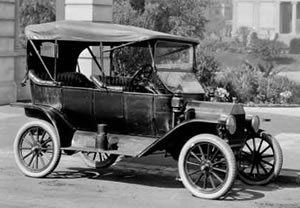
Ford’s Model T, the working man’s car, could be bought for around $300 in the 1920s. A more upscale manufacturer, Studebaker, advertised their “Big Six Touring Car” for $1750. It had seating capacity for seven with a big six cylinder engine that “would not lose power on any hill.” Studebaker’s stripped down model went for $975.
The 1920’s DJIA peaked on 03-September-1929 at 381.17. Ford stopped manufacturing their Model T in 1927, but I suspect that working class cars could have been purchased for what the Dow went for at its 1929 top. The same could be said for the DJIA on 09-October-2007’s $14,146.
If one only looks at car prices, it would appear that the DJIA (without dividends) broke even after 80 years of inflation. But James Grant, an authority of credit of the 20th Century, would note that car loans for consumers were not common in the 1920s. In other words, most Model Ts were cash purchases from savings. This was not the case in October 2007. DJIA in 2007 could match the cash price of a modest car, but not the total cost when interest payments from car loans are included.
– Mark Lundeen, The 1929 & 2007 Bear Market Race to the Bottom, Report #69

